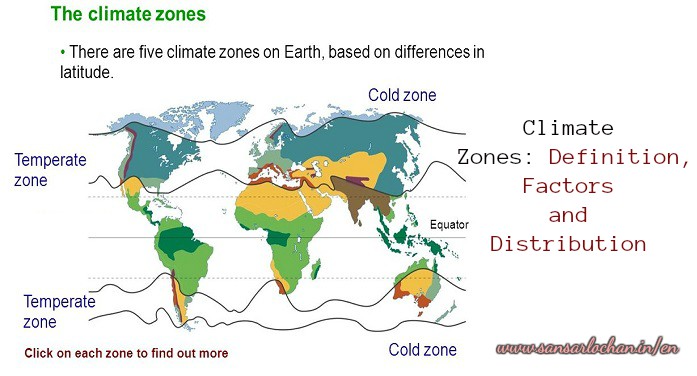Climates vary across the globe. The chief cause of such variation is the sun and its radiance. The sun rays fall on the different parts of the earth at different angles. While at the equator the angle of the sun is almost at 90°, it is almost 0°C around the polar circle. This variance results in variation of warmth in the different parts of the earth. The areas where the acuteness of the sunrays is greater are hot in comparison to those where it is less. For example, the parts of the earth falling at the equatorial line have hot temperatures throughout the year. On the other hand, at the poles the sun falls almost horizontally and hence the temperature there is very low. That is why they are capped with ice and have long sunless days and nights. The resultant variations in climatic conditions are described by the geographers as climate zones.
Climate Zones on the basis of Temperature
If we go by the criterion of temperature, we will see that there are four major climate zones in the world. These are as below –
- Tropics from 0°-23.5°
- Subtropics from 23.5°-40°
- Temperate Zone from 40°-60°
- Cold Zone from 60°-90°
A brief description of climate features found in the above-noted zones are as below –
Tropical Zone
Through high temperatures, more water evaporates and the air is moist. This results in creation of frequent and dense cloud cover that diminishes the effect of solar radiation on the ground temperature.
Subtropical Zone
Nearly all the deserts in the world fall in this zone.
Temperate Zone
This zone receives less heat through solar radiation since the sun shines at a very flat angle toward the ground.
Cold Zone
Because of the horizontal incidence of sunrays the temperature here is extremely low and the day length varies most in this zone. Vegetation is very few and far between.
Role of Altitude
It may be however be noted that temperature is affected not only by latitude but also by altitude. As we are aware temperature decreases as we move up in the mountains. Here the temperature is less compared to the valley on which such mountains stand.
What is weather?
Weather denotes the atmospheric conditions of an area at a particular time. For instance, if we are talking about the weather of our town, we might be referring to the brightness of the sun or the speed of the wind or the occurrence of clouds in the sky.
What is Climate?
Unlike weather, climate describes the atmospheric conditions occurring over a long period of time. These atmospheric conditions are called meteorological variables, such as patterns of variation in temperature, humidity, atmospheric pressure, wind, rainfall, atmospheric particle count etc.
Factors of Climate
The climate of a region is influenced by five components of the climate system that is atmosphere, hydrosphere, cryosphere, lithosphere and biosphere. The climate of a location is affected by its latitude, terrain, altitude as well as nearby water bodies and their currents.
Modern Classification of Climate Zones
Modern geographers divide the world in five primary climate types based on average monthly values of temperature and rainfall.
- Tropical
- Dry
- Mild mid-latitude
- Cold mid-latitutde
- Polar
These five primary classes are further divided into 12 secondary climatic zones. The main characteristics of these zones are illustrated in the following description :-
- Rainforest – High rainfall (69 in-79 in), Mean monthly temperatures exceed 18°C.
- Monsoon – Seasonal wind brings about rainy season. Regions within North America, South America, Sub-Saharan, Australia and East Asia are monsoon regimes.
- Tropical Savanna – Average temperatures at or above 18°C year round and rainfall between 30 in to 50 in.
- Humid Subtropical – Most summer rainfall occurs during thunderstorms and from occasional tropical cyclones.
- Humid Continental – Average daily temperature above 10°C, falls to -3°C.
- Oceanic Climate – Precipitation year-round and plentiful. Found among the west coasts at the middle latitudes of all continents and in south eastern Australia.
- Mediterranean Climate – Occurs in the Mediterranean coasts, some areas of Western North America, Western and South Australia, Southwestern Africa and in central Chile. Hot, dry summers and cool, wet winters.
- Steppe – Dry grassland. Annual temperatures in the summer upto 40°C and -40°C in winter.
- Subarctic Climate – Little precipitation. Monthly temperature above 10°C for a quarter of the year. Permafrost visible in a big part of the area due to chilling winters. Winter temperature average below 0°C.
- Tundra – In the far Northern Hemisphere, north of the taiga forest belt. Includes extensive areas of Northern Russia and Canada.
- Polar Ice-Cap or Polar Ice Sheet – Covered in ice. Lower surface temperatures because of lack of solar radiation.
- Desert – Very little precipitation. Dry temperature in summer up to 45°C. 0°C. in winter. Extremely low humidity.
Also read :>>
Brief Note on Indian Climate, Monsoon and Rainfall
